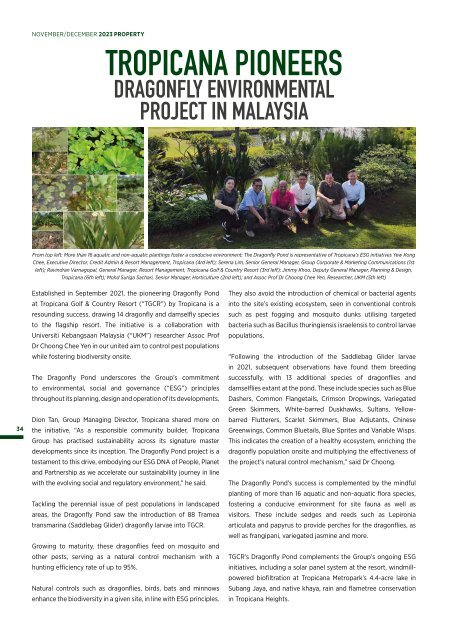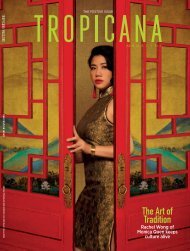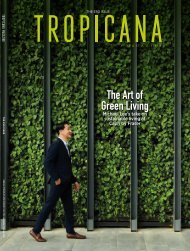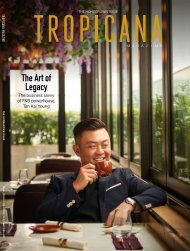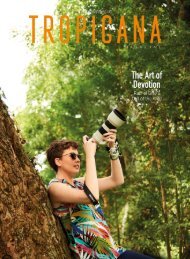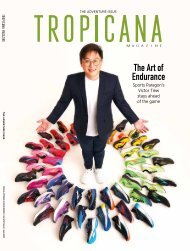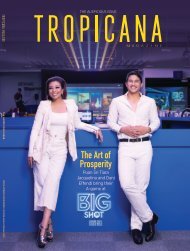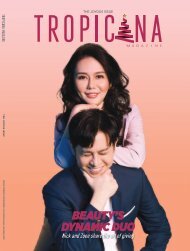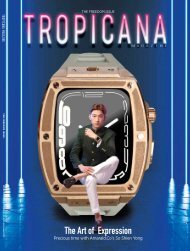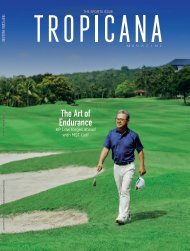Tropicana November-December 2023 #151 The Holiday Issue
Tropicana Magazine November-December 2023 #151 The Holiday Issue
Tropicana Magazine November-December 2023 #151 The Holiday Issue
You also want an ePaper? Increase the reach of your titles
YUMPU automatically turns print PDFs into web optimized ePapers that Google loves.
NOVEMBER/DECEMBER <strong>2023</strong> PROPERTY<br />
TROPICANA PIONEERS<br />
DRAGONFLY ENVIRONMENTAL<br />
PROJECT IN MALAYSIA<br />
From top left: More than 16 aquatic and non-aquatic plantings foster a conducive environment; <strong>The</strong> Dragonfly Pond is representative of <strong>Tropicana</strong>’s ESG initiatives Yew Kong<br />
Chee, Executive Director, Credit Admin & Resort Management, <strong>Tropicana</strong> (4rd left); Serena Lim, Senior General Manager, Group Corporate & Marketing Communications (1st<br />
left); Ravindran Varnagopal, General Manager, Resort Management, <strong>Tropicana</strong> Golf & Country Resort (3rd left); Jimmy Khoo, Deputy General Manager, Planning & Design,<br />
<strong>Tropicana</strong> (6th left); Mohd Suriga Sachari, Senior Manager, Horticulture (2nd left); and Assoc Prof Dr Choong Chee Yen, Researcher, UKM (5th left)<br />
34<br />
Established in September 2021, the pioneering Dragonfly Pond<br />
at <strong>Tropicana</strong> Golf & Country Resort (“TGCR”) by <strong>Tropicana</strong> is a<br />
resounding success, drawing 14 dragonfly and damselfly species<br />
to the flagship resort. <strong>The</strong> initiative is a collaboration with<br />
Universiti Kebangsaan Malaysia (“UKM”) researcher Assoc Prof<br />
Dr Choong Chee Yen in our united aim to control pest populations<br />
while fostering biodiversity onsite.<br />
<strong>The</strong> Dragonfly Pond underscores the Group’s commitment<br />
to environmental, social and governance (“ESG”) principles<br />
throughout its planning, design and operation of its developments.<br />
Dion Tan, Group Managing Director, <strong>Tropicana</strong> shared more on<br />
the initiative. “As a responsible community builder, <strong>Tropicana</strong><br />
Group has practised sustainability across its signature master<br />
developments since its inception. <strong>The</strong> Dragonfly Pond project is a<br />
testament to this drive, embodying our ESG DNA of People, Planet<br />
and Partnership as we accelerate our sustainability journey in line<br />
with the evolving social and regulatory environment,” he said.<br />
Tackling the perennial issue of pest populations in landscaped<br />
areas, the Dragonfly Pond saw the introduction of 88 Tramea<br />
transmarina (Saddlebag Glider) dragonfly larvae into TGCR.<br />
Growing to maturity, these dragonflies feed on mosquito and<br />
other pests, serving as a natural control mechanism with a<br />
hunting efficiency rate of up to 95%.<br />
Natural controls such as dragonflies, birds, bats and minnows<br />
enhance the biodiversity in a given site, in line with ESG principles.<br />
<strong>The</strong>y also avoid the introduction of chemical or bacterial agents<br />
into the site’s existing ecosystem, seen in conventional controls<br />
such as pest fogging and mosquito dunks utilising targeted<br />
bacteria such as Bacillus thuringiensis israelensis to control larvae<br />
populations.<br />
“Following the introduction of the Saddlebag Glider larvae<br />
in 2021, subsequent observations have found them breeding<br />
successfully, with 13 additional species of dragonflies and<br />
damselflies extant at the pond. <strong>The</strong>se include species such as Blue<br />
Dashers, Common Flangetails, Crimson Dropwings, Variegated<br />
Green Skimmers, White-barred Duskhawks, Sultans, Yellowbarred<br />
Flutterers, Scarlet Skimmers, Blue Adjutants, Chinese<br />
Greenwings, Common Bluetails, Blue Sprites and Variable Wisps.<br />
This indicates the creation of a healthy ecosystem, enriching the<br />
dragonfly population onsite and multiplying the effectiveness of<br />
the project’s natural control mechanism,” said Dr Choong.<br />
<strong>The</strong> Dragonfly Pond’s success is complemented by the mindful<br />
planting of more than 16 aquatic and non-aquatic flora species,<br />
fostering a conducive environment for site fauna as well as<br />
visitors. <strong>The</strong>se include sedges and reeds such as Lepironia<br />
articulata and papyrus to provide perches for the dragonflies, as<br />
well as frangipani, variegated jasmine and more.<br />
TGCR’s Dragonfly Pond complements the Group’s ongoing ESG<br />
initiatives, including a solar panel system at the resort, windmillpowered<br />
biofiltration at <strong>Tropicana</strong> Metropark’s 4.4-acre lake in<br />
Subang Jaya, and native khaya, rain and flametree conservation<br />
in <strong>Tropicana</strong> Heights.


